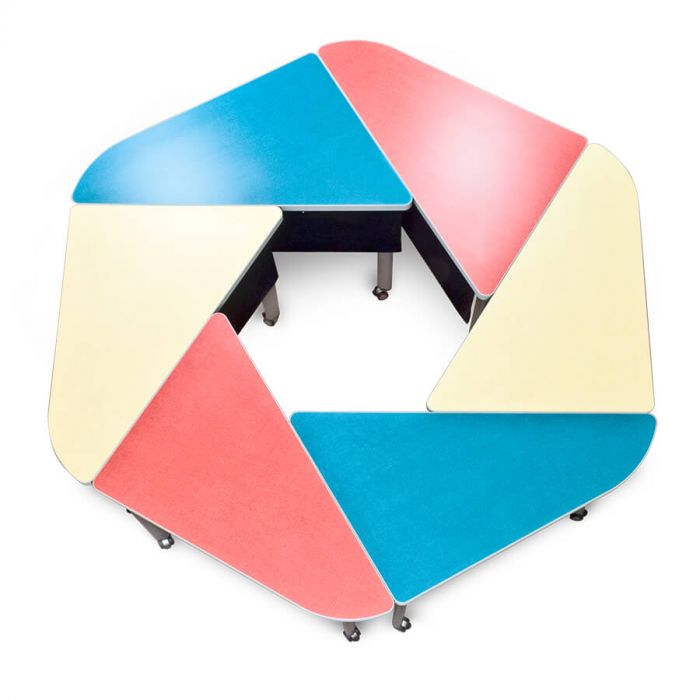
The impact of the classroom environment on student learning cannot be understated. With collaborative furniture, you can create an effective learning environment for your students. Using a collaborative desk layout will give your students more opportunities to work together. It also helps teachers develop more engaging lessons. But what is the best way to organize desks in a classroom? Let’s talk about arranging your classrooms and how it impacts learning.
How Do You Arrange Desks in the Classroom?
Arranging desks in a classroom makes a big difference in how students learn. There are several things to consider when setting up a classroom. Ask questions like:
● What age are the students? All ages learn differently. Younger students might benefit from more collaborative workspaces. Older students might work better with technology integration. Understanding which setup works best for your students is essential to creating a helpful learning environment.
● What is the size of the classroom? You might think classrooms with more space are easier to design. But any size room is easy to arrange when you use adaptable furniture. However, you might need to test out a few steps before deciding on the ideal layout. Whether you’re looking for computer lab desks, collaborative desks, or computer tables, SMARTdesks helps you elevate any size of classroom.
● What subject is being taught? English classrooms are different from art classrooms. Designing your space to accommodate the subject matter is important for effective learning.
● What special needs do individual students have? Some students might have special needs in their learning plan. Not every student learns the same. Certain disabilities that affect a student’s ability to learn in certain layouts. That means arranging the classroom should take different learning styles and disabilities into consideration.
Keep in mind that depending on the lesson or activity, the desk arrangement may need to be modified. Be open to experimenting with various setups to see which suits your students the best. Some arrangements include:
● Traditional Rows: Desks are arranged in rows facing the front of the classroom. The teacher lectures using the whiteboard or screen located at the front—a layout that helps teachers see all students at once. That means students can easily engage with the teacher. However, this arrangement isn’t great for collaboration between students.
● Clusters/Groups: Desks are grouped into small clusters facing each other. Collaboration is encouraged, which leads to rich discussions. A cluster setup also allows for flexibility, because students are enabled to easily move around the classroom.
● U-Shaped: Desks are arranged in a U-shape facing the front of the classroom. Typically the teacher’s desk is front-and-center in the room. Students collaborate with others easier than in rows, which leads to better discussions among students.
● Circle: Desks are arranged in a circle, so students face each other, encouraging open discussion. It is also ideal for collaboration, because students can all see and interact with one another. Not all students will face the front, so lecturing with a whiteboard is less effective.
● Semi-Circle: Desks are arranged in a half-circle facing the front of the classroom. As with rows and groups, teachers can instruct students from the front. It also encourages discussion like the U-shape.
Every layout has advantages and disadvantages, so educators should select one that fits the specific needs of their students and the activities they want to do in class. One study suggests that the best classroom layout should be left to the teachers. They know which arrangement is the most effective for their class. It also depends on their teaching style. Using SMARTdesks adjustable furniture, spaces are easily adapted to teachers’ and students’ needs.
What Is the Best Layout for a Classroom?
It depends on your subject, the students in your class, and what teaching style you prefer. If you’re looking for creative ways to engage students, the best layout for learning could be group desks. Clusters encourage more interaction between students. Students in clusters produce high quality work found in other classroom layouts like traditional rows, but clustered students also produce a greater quantity of work. Clusters are the best 21st century solution to learning.
How Does Seating Arrangement Affect Learning and Development?
Seating arrangements impact the way students learn. One study found that “flexible learning environments are most conducive to student engagement, ownership, and achievement.” Students picked flexible classroom spaces over more traditional tables and chairs. In fact, it’s suggested that teachers consider redesigning their classroom. Another article states something similar. Giving the students different, flexible options helps them be more engaged. Some teachers actively add different seating arrangements to accommodate students’ needs. The general consensus is that teachers should choose the seating arrangements for students to create an effective learning environment.
SMARTdesks for Smart Classroom Solutions
With SMARTdesks, you have the freedom to design a classroom that meets the needs of your students. Make sure they’re getting the best learning experience possible with a variety of options for clusters, like the Collab Active Learning Conference Table or the flipIT Lift Motorless Monitor Lift Computer Desk. Set up your classroom to meet the needs of your students with SMARTdesks, creating classroom layouts for effective learning. Reach out to us for a consultation and let us design the perfect space for learning.


